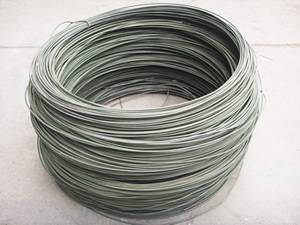Nickel Wire
 The nickel wire is made by advanced vacuum melting process, and by forging, rolling, annealing and drawing.It is acid resisting and alkali resisting. The products are used in electric apparatus and chemical machinery.
The nickel wire is made by advanced vacuum melting process, and by forging, rolling, annealing and drawing.It is acid resisting and alkali resisting. The products are used in electric apparatus and chemical machinery.
Application:
1) For vacuum coating
2) For making valves grid, inner components of vacuum valves
3) For making lead, supporting wire
4) Used for nickel wire mesh for battery production.
Inner packing: attached labels indicate detail specification and manufacture information
Nickel wire Dia: from 0.025mm to 8.0mm.
Pure Nickel Wire Chemical Composition
| TYPE | NICKEL | Main substance composition | Total substance composition | |||||||||||||
| C | Si | Fe | Mg | Cu | S | Zn | As | Cd | P | Sn | Sb | Pb | Bi | |||
| N6 | >99.5% | 0.1 | 0.1 | 0.1 | 0.1 | 0.6 | 0.015 | 0.007 | 0.004 | 0.004 | 0.002 | 0.002 | 0.002 | 0.002 | 0.002 | <0.5% |
Nickel200(UNS N02200) Chemical Composition %
| C | Cu | Mn | Ni | S | Si |
| Max | Max | Max | Min | Max | Max |
| 0.10 | 0.25 | 0.30 | 99.2 | 0.005 | 0.10 |
Nickel200(N6): A commercially pure nickel alloy possessing good corrosion resistance and relatively low electrical resistivity. Has been used in a wide variety of applications including food handling equipment, magnetically actuated parts, sonar devices, and electrical and electronic leads. Meets ASTM B160 specification requirements. The company can help: Select suitable component material with proper type. Providing instant installed components with better economic achievement.
Nickel201(UNS N02201) Chemical Composition %
| C | Cu | Mn | Ni + Co | S | Si | Fe |
| Max | Max | Max | Max | Max | Max | Max |
| 0.02 | 0.25 | 0.35 | 99 | 0.001 | 0.35 | 0.40 |
Nickel 201(N4) has an excellent corrosion resistance same as Nickel200. Because it is a low-carbon material (up to 0.02%), Nickel 201 in the long term is 600℉- 1400℉.
Under(315℃ - 760℃) and there is no contact with the carbonaceous material circumstances will not occur due to intergranular precipitation of carbon or graphite embrittlement occurs.
Therefore, at temperatures exceeding 600℉ (315℃) in the case of nickel 201 is more popular than nickel200. Nickel 201 is used must be able to withstand oven until 2000℉ (1100℃) the oxidation laboratory crucibles. At temperatures above 600℉ (315℃) in the case, the material may cause the sulphide intergranular embrittlement.
Products List




Contact Us
Add: Industrial Zone of Anping County, Hebei Province, China.Tel: +86-133-6331-6877
E-mail: sales@generalmesh.com